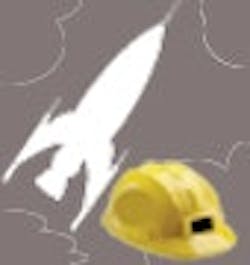NASA Still Propels Engineers
Yes, NASAs lunar explorations ignited a generation of U.S. engineers eager to propel themselves into space via rocket or whatever they could invent to escape Earths gravitational pull.
And although that groundswell of astro-enthusiasm took place about 50 years ago, the National Aeronautics and Space Administration still challenges and encourages children to pursue career paths in science, technology, engineering and mathematics.
A visit to the website reveals a plethora of news, programs, activities and information for elementary, secondary and higher-education students, as well as teachers. But NASAs approach is astoundingly proactive. In April, astronauts flying on a space shuttle mission to service the Hubble Space Telescope spoke to students at five U.S. middle schools in New York, Texas, Michigan, Pennsylvania and Washington, along with an invited student audience at Goddard Space Flight Center in Greenbelt, Md. through NASAs Digital Learning Network. Topics of discussion included details about the upcoming STS-125 mission to service Hubble and the crews career diversity. Each has a doctorate degree in a science, technology, engineering and mathematics discipline.
The goal of the DLN is to link students and educators with NASA experts. It offers videoconferencing at no charge, providing educational experiences to students and teachers from kindergarten to college around the world.
And NASAs active role in nurturing future engineers doesnt begin and end on the Internet. For a more hands-on approach, the space agency offers competitions worthy of tomorrows engineers and space pioneers. Interestingly enough, this U.S. government agency is reaching out to children all over the world.
The high school division of NASAs 15th annual Great Moonbuggy Race at the U.S. Space & Rocket Center in Huntsville, Ala., was won by students from Erie High School in Kansas.
Finishing the simulated lunar race course in 3 min, 17 sec, the winning teams original moonbuggy design was faster than entries from 21 other high school teams that came from as far away as Germany.
The 2007 high school moonbuggy champions, from Huntsville Center for Technology, which fielded two teams this year, finished second and third in the competition.
The race is, of course, inspired by the original lunar rover designed by engineers at NASAs Marshall Space Flight Center in Huntsville. The first rover navigated the moons surface during the Apollo 15 mission in 1971 and two subsequent Apollo lunar missions.
This past October, teams began designing their rovers to cover the half-mile course of craters, gullies and ridges made of plywood and tires and covered with a realistic layer of gravel and sand. Each lunar rover is powered and driven by a male and a female driver.
The Marshall Center presented the first-place team with a trophy depicting NASAs original lunar rover, and gave plaques and certificates to the two runners-up. The first-place team also received a one-week trip to the advanced Space Camp program at the Space & Rocket Center, courtesy of ATK Launch Systems and Jacobs Technology. Individuals on all three winning teams received commemorative medals and cash prizes from ATK Launch Systems.
The competition also presented awards to teams for best design, best spirit, uniqueness, best pit crew, best first effort, most improved team entry and best safety systems, which was won by the German Space Education Institute team from Leipzig. The team from Fajardo, Puerto Rico, overcame a buggy-toppling crash to earn the Rookie Award.
Student innovators from the University of Evansville in Evansville, Ind., sped past 23 teams from around the globe to win the college division of the Great Moonbuggy Race. Finishing in the top three along with Evansville were second-place winners from Murray State University in Murray, Ky., and third-place racers representing Canadas Carleton University in Ottawa, Ontario.


